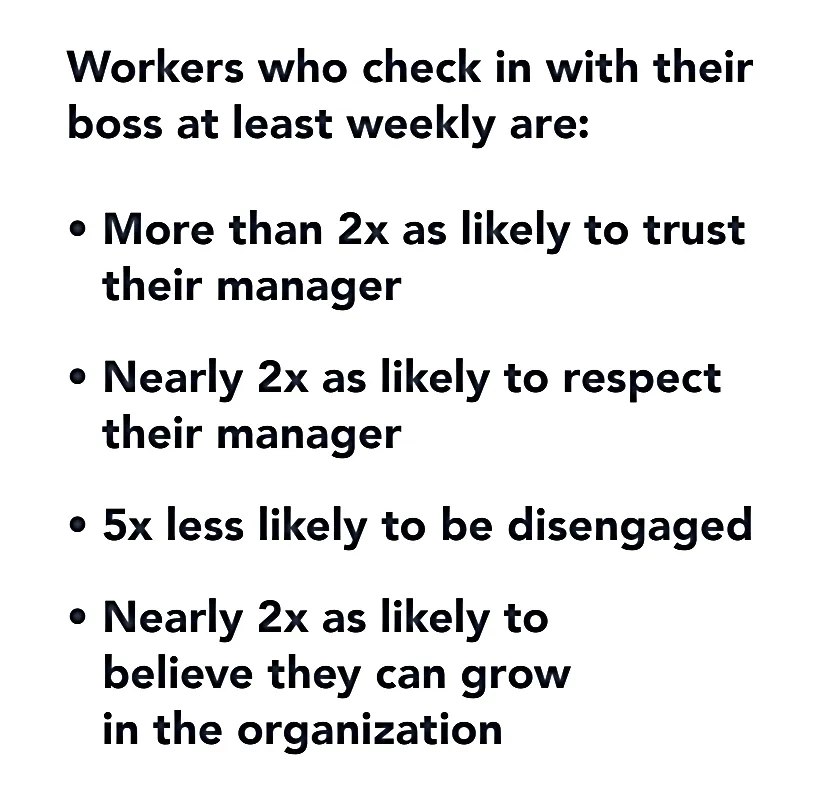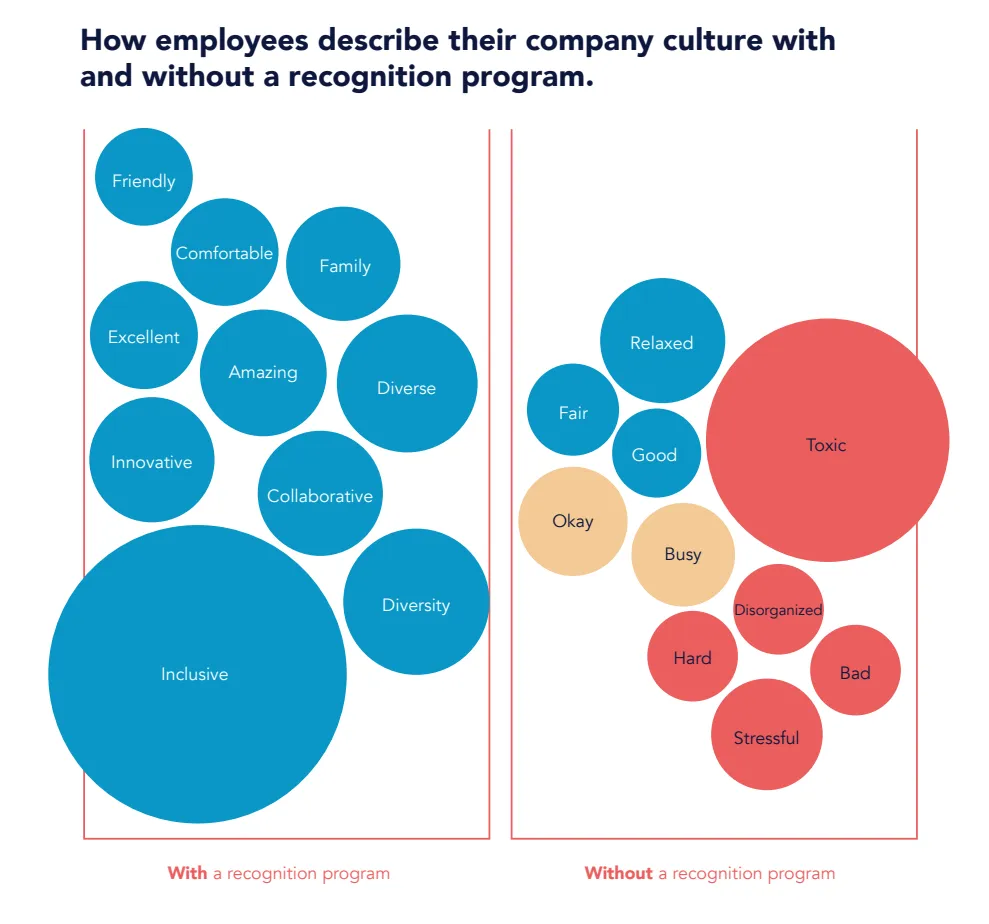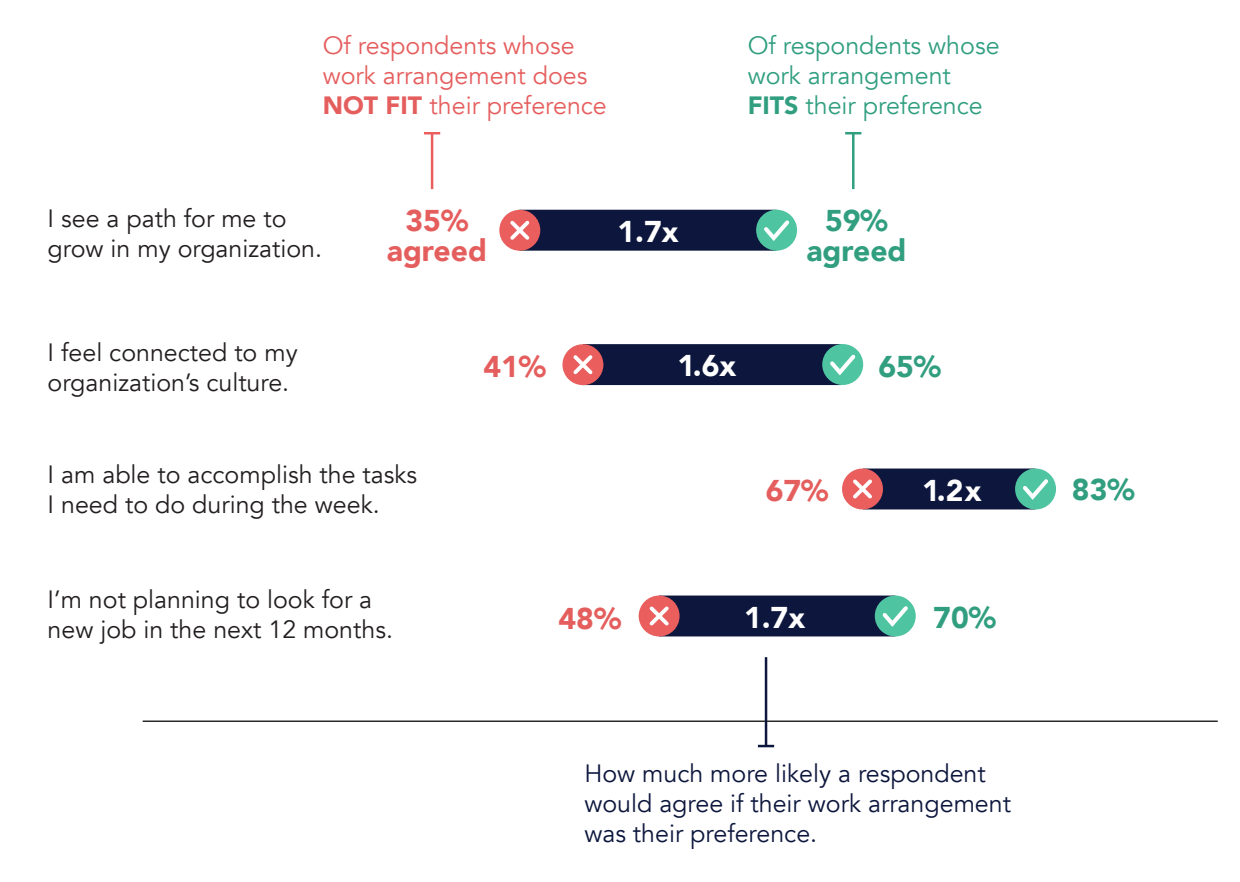Toxic Work Culture: Signs of an Unhealthy Work Environment & How to Fix It
MIT Sloan conducted research into the top predictors of attrition during the Great Resignation. They found that workers were 10.4 timesOpens in a new tab more likely to leave their jobs because of a toxic work culture than because of compensation.
This statistic shows employees value a healthy workplace environment more than they value their pay. And for good reason.
If the average full-time employee spends 40 hours a week at their job, a toxic work culture is going to wear them down, leading to feelings of burnout and disengagement.
At worst, a toxic work culture could even compromise their physical and mental health. This is not to mention the financial burden of toxicity in the workplace.
In this post we'll examine what factors contribute to a toxic workplace, the cost of toxicity in your organization, and how to combat a bad work culture to cultivate a work environment that puts your people first and saves your bottom line.
Elements of a toxic workplace
Understanding the signs of a toxic workplace is the first step toward remedying the problem. While toxicity may not show itself in the same way in all workplaces, leaders should know these common factors.
Here are some signs of a toxic workplace culture:
Disengagement, low enthusiasm, and negativity

A recent Gallup pollOpens in a new tab found that disengaged employees are in the majority, not the minority. In the United States, only 36% of workers are engaged at work. This leaves 50% of employees disengaged and an additional 15% actively disengaged from their work.
Low engagement and overall employee morale can feed into a vicious cycle. Unhappy employees can seep negativity into the workplace, which then infects everyone else.
If you notice low enthusiasm and actively disengaged team members, it’s important to get to the root of the issue, as it can have a big impact on your bottom line.
“Every year, disengaged workers cost the U.S. economy up to $605 billion in lost productivity—they frequently arrive late to work, or miss shifts entirely, and disrupt others with their negativity.”
Working with your team to understand the cause of their dissatisfaction can help you address their concerns and promote a happier, more productive workplace culture.
Role confusion and dysfunction
Uncertainty about roles and responsibilities can lead to workplace dysfunction. Employees may experience anxiety over their supervisor’s expectations when their roles aren’t well-defined or clearly communicated.
In some cases, this can lead to conflicts between team members regarding who’s responsible for what. Co-worker conflicts can lead to breakdowns in workplace relationships that ultimately damage your whole team.
Setting clear boundaries and expectations and communicating changes clearly can help you prevent this kind of dysfunction.
Chronic and excessive stress
Employees may experience excessive stress for many reasons. Common contributors include being overworked, feeling uncertain about expectations, disagreeing with bosses or co-workers, or struggling with communication.
Fears of failure and difficulty communicating with team members and supervisors may cause chronic stress, which can eventually lead to employee burnout.
Pervasive office gossip
Gossip often flourishes in hostile work environments. When employees talk about each other behind their backs, it can signify a negative style of communication that ultimately causes distrust, drama, distractions, and, in the worst cases, bullying.
Gossip becomes toxic when it hinders employees from communicating openly with each other, or turns malicious, such as when employees spread hurtful rumors about others.
High turnover rates
If you notice high turnover rates at your organization, it may be time to inspect your culture. While employees leave companies for a variety of reasons, when your company constantly needs to replace staff, it could be a sign of problems with your workplace.
In fact, data from SHRM shows that one out of five employeesOpens in a new tab have left their jobs in the last five years because of their workplace culture.
Causes of a toxic workplace
Toxic work cultures can stem from many factors, but here are a few common causes of toxicity in the workplace:
- Poorly defined core values: A company without well-defined values can suffer from internal inconsistencies and a lack of brand identity. Promoting strong values gives employees a sense of belonging within a company, and an organizational identity to internalize and act on.
- Inconsistent expectations: When expectations change abruptly or frequently without support, employees can feel disengaged, confused, and frustrated. Maintaining consistent expectations and providing support through changes reduces anxiety and encourages connection.
- Unclear communication: Communication goes both ways. Employees need clear communication from their supervisors, and they need leaders who will listen to their concerns and encourage them to express themselves honestly.
- Rampant bullies and cliques: Bullying is a real problem in the workplace, and it can decrease your employees' sense of psychological safety. Eventually, this can result in significant problems like reduced self-esteem, increased susceptibility to mental health issues, and higher rates of burnout.
In an interview with HR Bartender, Workhuman Global Head of Analytics Jesse Harriott said, “Psychological safety is critical for employees to be productive, strive for excellence, innovate, and generally bring their best selves to the workplace. Toxic work cultures are a breeding ground for things that undermine psychological safety.”
- Emphasis on outputs, not people: A workplace that cares more about its production than its people is likely to breed toxicity. Companies need to invest in the wellbeing of their people first.
The costs of a toxic work environment
The financial and human costs of a toxic work environment are too high to ignore. Let’s look at the hard costs of a toxic workplace, along with its intangible effects.
How does a toxic work environment affect a company as a whole?
SHRM reports that turnover due to bad work cultures cost American businesses $223 billion over the last five years. Opens in a new tab
In our own research, data from WorkHuman's the Human Workplace Index (HWI) helps to contextualize turnover rates during the Great Resignation, which shaped the landscape of corporate and industrial America during and after the COVID-19 pandemic.
In particular, the Great Resignation refers to a mass exodus of employees who left their jobs during the pandemic.
According to a recent HWI survey, 34% of survey participants voluntarily left their jobs during the pandemic.
Of that 34%, as many as 28% cited mental health and a toxic workplace culture as their reason for leaving.
This data shows that toxic work cultures contribute to a significant portion of worker turnover, which in turn costs businesses an exorbitant amount of money.
And that's just turnover. It's harder to measure just how much companies lose when toxic work cultures prevent their employees from maximizing their productivity.
What we know is that pervasive feelings of stress, burnout, and fatigue have a negative impact on worker productivity, while cultivating a positive work culture is important for improving wellness and driving performance.
See also: What is Toxic Positivity at Work?
What are the effects of toxicity in the workplace?
The effects of toxicity in the workplace are numerous. To name a few:
- Reduced employee engagement
- Higher rates of burnout
- Greater rates of absenteeism and turnover
- Decreased feelings of psychological safety in employees
- More symptoms of depression and anxiety in employees
- Pervasive feelings of negativity
- More company expenses
- Increased interpersonal conflicts
Combating a toxic culture
Fortunately, there are actionable steps you can take to prevent and reduce toxicity in your workplace culture. As an HR professional, you can use these tips to fix, deal with, or avoid a toxic workplace culture.
Put your people first
A people-first company culture is an approach that aims to support and recognize employees to help them feel more connected to the organization and motivated to do their best work.
Employees today have little interest in companies that value profit over people. Instead, they are looking for organizations that wholeheartedly understand that people are what make profit.

At the end of the day, it's your people who keep your company running. If they don't have the resources they need to thrive, they can't excel. Your first step to fostering a positive workplace culture is to learn about your employees and their needs.
This means creating opportunities to have meaningful, honest conversations with the people at your company. Ask them about current barriers keeping them from doing their best work and involve them in brainstorming solutions that address their specific needs.
Set a precedent of open and honest communication through wellness surveys or soliciting other forms of feedback.
Check-in regularly

More frequent check-ins with employees play a crucial role in combating a toxic work culture.
Workers who check in with their boss at least weekly are:
- More than 2x as likely to trust their manager
- Nearly 2x as likely to respect their manager
- 5x less likely to be disengaged
- Nearly 2x as likely to believe they can grow in the organization
Regular check-ins foster open, honest communication, allowing employees to express concerns, seek guidance, and feel heard. Workers who engage in weekly check-ins are significantly less likely to be disengaged, highlighting the importance of consistent communication.
These interactions build trust, connection, and a sense of belonging, which are essential in preventing burnout and disengagement.
Check-ins also provide a platform for managers to understand employee challenges, motivations, and stressors, contributing to a healthier employee-manager relationship and a more psychologically safe work environment.
By prioritizing frequent and meaningful check-ins, organizations can address workplace issues proactively, enhance employee wellbeing, and ultimately transform a toxic work culture into a supportive and collaborative one.
Role model expectations
Ensure your leaders do their part to uphold your company's work culture. This means developing a strong, consistent internal culture that all leaders follow. You may even create formal guidelines to help them standardize their approach to promoting positivity at your company.
If needed, consider providing training opportunities to teach leaders about toxic workplace cultures and how to prevent them.
Hire the right people
While fixing your company's culture starts at the top, don't forget to look at who you hire at all levels of your organization. In some cases, attitude may even be more important than skill set when choosing the right employees for your team.
While employees can learn skills that help them do their jobs, it's harder to train someone out of their toxic behaviors. Picking employees who have positive, team-oriented attitudes and strong communication skills can help you staff your organization with people who resist toxicity.
If you find yourself choosing the wrong people over and over again, look at your hiring process. Evaluate where you're sourcing your employees and what strategies you're using during the hiring process to filter out candidates with toxic tendencies.
See also: 5 Types of Toxic Employees in the Workplace and Signs to Look Out For
Recognize and reward
To combat a toxic culture, find ways to practice gratitude in the workplace daily. Simple gestures like thanking your employees for their work can go a long way. Implementing a recognition program can take it a step further.
In fact, our research has found that the way employees describe their company culture is vastly different when there is and isn't a recognition program in place.

Recognizing successes, both personal and professional, makes your team feel appreciated and fosters a greater sense of belonging. Employees who feel that their company values their effort are likely to feel happier, which can improve workplace attitudes and contribute to a culture of celebration rather than one of toxic competition.
You can also encourage peer-to-peer recognition, which prompts members of a team to praise each other to build a stronger workplace community.
Another way to show gratitude is through rewarding positive behaviors. Cash bonuses, extra time off, or small prizes like gift cards and snacks can demonstrate appreciation for a job well done.
Don't wait for a special occasion to show gratitude. Make it an intrinsic aspect of your company's culture.
Flexible work environments
In our Workhuman iQ survey, we found where employees work matters. But more specifically, understanding where they want to work matters even more. It turns out it can affect the entirety of the employee experience.
Of those who reported their work arrangement was their preference, 83% said they are able to accomplish the tasks they need to during the week, and 74% felt a sense of connection with colleagues.
Employees working in their preferred arrangement were also 1.6x more likely to feel highly engaged compared to their colleagues not working in their preferred working arrangement.
When work arrangement meets employee preference, it’s a boon to development, connection, sense of accomplishment, and retention.

FAQs
Here are the answers to some additional frequently asked questions about toxic work cultures.
How does a bad work environment affect employees?
A bad work environment affects employees by making them feel demoralized and disengaged. It can lead to excessive stress, fatigue, depression and anxiety, and even feelings of burnout.
Employees in a toxic work environment may feel unmotivated, which can decrease their productivity. They may have a harder time engaging with others and communicating openly about their needs and boundaries.
What qualifies as a toxic work environment?
There's no formal classification system that qualifies a work environment as toxic. Ultimately, it's up to the people in that environment to determine whether it's healthy for them.
In general, toxic environments are ones where internal conflicts prevent individuals from fulfilling their responsibilities or otherwise keep them from enjoying life and achieving the goals they define for themselves.
What are the signs of a toxic employee?
These may be signs of a toxic employee:
- Shows entitlement beyond what's earned
- Demonstrates aggression toward others
- Deploys passive-aggression and defensiveness
- Holds values that don't align with the company's
- Acts selfishly
- Is unwilling to listen
- Refuses to accept criticism
- Gossips and creates drama
- Takes credit for the work of others
Conclusion
A toxic work culture can hold your organization back from achieving its goals.
Not only can it lead to high rates of turnover and reduced employee productivity that hurts your bottom line, but it's a human-centered problem that can actively harm the people at your company.
Don't let a toxic work culture keep you from putting your people first.
Use WorkHuman's Social Recognition tools to help you solve your culture problems and build the people-first workplace your employees deserve.
About the author
Ryan Stoltz
Ryan is a search marketing manager and content strategist at Workhuman where he writes on the next evolution of the workplace. Outside of the workplace, he's a diehard 49ers fan, comedy junkie, and has trouble avoiding sweets on a nightly basis.